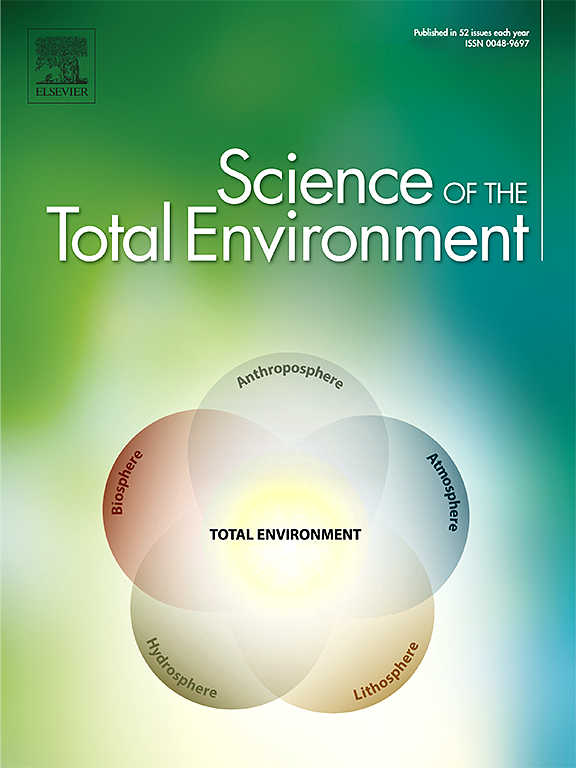A global review on perfluoroalkyl acids (PFAAs) in the riverine systems: Environmental behaviours and risks implications
IF 8.2
1区 环境科学与生态学
Q1 ENVIRONMENTAL SCIENCES
引用次数: 0
Abstract
This review provides a comprehensive global overview of the occurrences, distribution, emissions, and associated risks of perfluoroalkyl acids (PFAAs) in riverine systems across both developed and developing countries including the United States (US), Spain, France, Netherlands, Germany, Pakistan, China, Korea, Vietnam, Italy, and Japan. Data for this review were systematically gathered through a comprehensive and structured search process using various databases, search engines, and academic repositories to identify relevant literature and studies. Human health risks were assessed using recommended United States Environmental Protection Agency (USEPA) models, including estimated daily intake (EDI), hazard risk (HR), and hazard index (HI) for each reported PFAA compound in the studied countries. The overall results revealed significant variability in PFAAs contamination from the 1950s to 2023, reflecting extensive industrial usage and increasing environmental concerns, with levels often exceeding the permissible limits set by environmental quality standards established by national or international regulatory authorities, agencies, and organizations. Among the studied countries, Italy exhibited the highest average sum of PFAA compounds (∑PFAAs) concentration in riverine water, ranging from 4.07 to 140.61 ng/L, with an average of 41.37 ng/L, followed by the Netherlands, China, Japan, the US, Pakistan, Spain, France, Germany, Korea, and Vietnam. Similarly, Germany showed the highest average ∑PFAAs concentration in riverine sediments, ranging from 40.25 to 213.00 ng/g, with an average of 126.63 ng/g, followed by China, Spain, the US, Pakistan, Vietnam, and Korea. Whereas, in riverine fish, Spain had the highest average ∑PFAAs concentration, ranging from 0.05 to 144.97 ng/g, with a mean of 15.94 ng/g, followed by Korea, Vietnam, and the US. From a human risk perspective, the highest average EDI of ∑PFAAs via riverine water consumption was observed in the dependent population of Italy (2.02 × 10−3 ng/L/day), followed by the Netherlands (8.24 × 10−4 ng/L/day), the US (5.56 × 10−4 ng/L/day), Pakistan (3.99 × 10−4 ng/L/day), Japan (3.69 × 10−4 ng/L/day), France (3.42 × 10−4 ng/L/day), China (2.58 × 10−4 ng/L/day), Spain (2.43 × 10−4 ng/L/day), Germany (1.17 × 10−4 ng/L/day), Korea (6.01 × 10−5 ng/L/day), and Vietnam (1.28 × 10−5 ng/L/day). For fish consumption, Spain recorded the highest average EDI of ∑PFAAs (9.92 × 100 ng/g/day) in its dependent population, followed by the US (3.44 × 100 ng/g/day), Korea (8.13 × 10−1 ng/g/day), and Vietnam (4.99 × 10−1 ng/g/day). The non-carcinogenic HR values for individual PFAA compounds via riverine water intake in the dependent populations of both developed and developing countries were within acceptable limits (<1). However, the HI values for ∑PFAAs intake via riverine fish consumption in the dependent population exceeded the threshold (>1) in the developed countries, the US and Spain, indicating higher potential risks associated with fish consumption in these countries. Given the inadequate wastewater treatment facilities in many regions, coupled with untreated runoff from urban areas and agricultural fields draining directly into rivers, this study underscores the urgent need for integrated prevention and control measures to mitigate PFAAs contamination in riverine systems and reduce associated risks. Ultimately, stricter regulations, improved monitoring, and enhanced water treatment technologies are crucial to reducing PFAAs contamination and safeguarding public health.

河流系统中的全氟烷基酸 (PFAAs) 全球综述:环境行为和风险影响。
本文章由计算机程序翻译,如有差异,请以英文原文为准。
求助全文
约1分钟内获得全文
求助全文
来源期刊

Science of the Total Environment
环境科学-环境科学
CiteScore
17.60
自引率
10.20%
发文量
8726
审稿时长
2.4 months
期刊介绍:
The Science of the Total Environment is an international journal dedicated to scientific research on the environment and its interaction with humanity. It covers a wide range of disciplines and seeks to publish innovative, hypothesis-driven, and impactful research that explores the entire environment, including the atmosphere, lithosphere, hydrosphere, biosphere, and anthroposphere.
The journal's updated Aims & Scope emphasizes the importance of interdisciplinary environmental research with broad impact. Priority is given to studies that advance fundamental understanding and explore the interconnectedness of multiple environmental spheres. Field studies are preferred, while laboratory experiments must demonstrate significant methodological advancements or mechanistic insights with direct relevance to the environment.
 求助内容:
求助内容: 应助结果提醒方式:
应助结果提醒方式:


